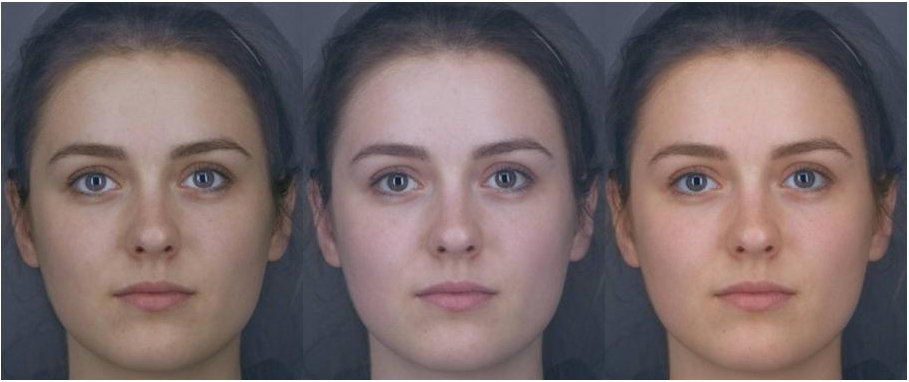
The face in the middle shows the woman's natural colour. The face on the left shows the effect of sun tanning, while the face on the right shows the effect of eating more carotenoids. Participants thought the carotenoid colour looked healthier. Image courtesy of Dr Ian Stephen
New research suggests eating vegetables gives you a healthy tan. The study, led by Dr Ian Stephen at The University of Nottingham, showed that eating a healthy diet rich in fruit and vegetables gives you a more healthy golden glow than the sun.
The research, which showed that instead of heading for the sun the best way to look good is to munch on carrots and tomatoes, has been published in the Journal Evolution and Human Behaviour.
Dr Ian Stephen, from the School of Psychology, University of Nottingham, Malaysia Campus, led the research as part of his PhD at the University of St Andrews and Bristol University. He said: “Most people think the best way to improve skin colour is to get a suntan, but our research shows that eating lots of fruit and vegetables is actually more effective.”
Dr Stephen and his team in the Perception Lab found that people who eat more portions of fruit and vegetables per day have a more golden skin colour, thanks to substances called carotenoids. Carotenoids are antioxidants that help soak up damaging compounds produced by the stresses and strains of everyday living, especially when the body is combating disease. Responsible for the red colouring in fruit and vegetables such as carrots and tomatoes, carotenoids are important for our immune and reproductive systems.
Dr Stephen said: “We found that, given the choice between skin colour caused by suntan and skin colour caused by carotenoids, people preferred the carotenoid skin colour, so if you want a healthier and more attractive skin colour, you are better off eating a healthy diet with plenty of fruit and vegetables than lying in the sun.”
Dr Stephen suggests that the study is important because evolution would favour individuals who choose to form alliances or mate with healthier individuals over unhealthy individuals.
Professor David Perrett, who heads the Perception Lab, said: “This is something we share with many other species. For example, the bright yellow beaks and feathers of many birds can be thought of as adverts showing how healthy a male bird is. What’s more, females of these species prefer to mate with brighter, more coloured males. But this is the first study in which this has been demonstrated in humans.”
While this study describes work in Caucasian faces, the paper also describes a study that suggests the effect may exist cross culturally, since similar preferences for skin yellowness were found in an African population.
The work was funded by the Biotechnology and Biological Sciences Research Council (BBSRC) and Unilever Research, and published with support from the Economic and Social Research Council (ESRC) and the British Academy and Wolfson Foundation.
Source: University of Nottingham
